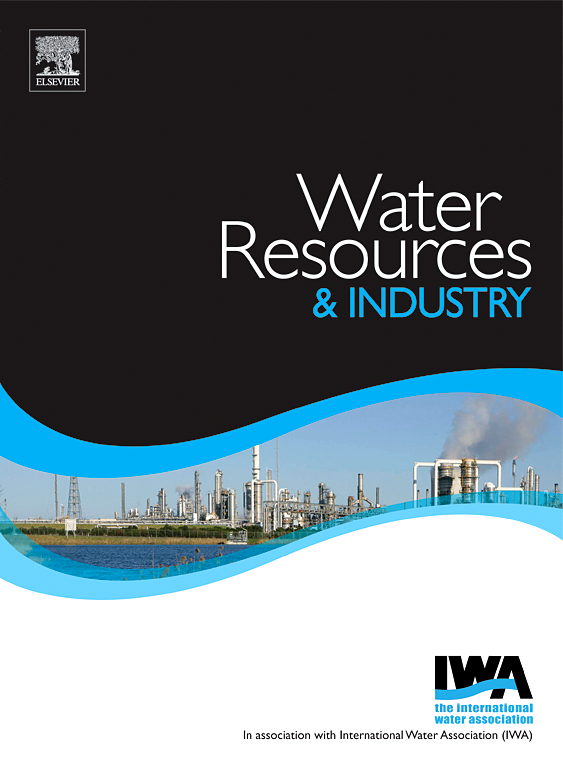Bio-waste to environmental purifier: Application of potato peel for acid red 73 adsorption from leather dyeing effluent
IF 4.5
3区 工程技术
Q1 WATER RESOURCES
引用次数: 0
Abstract
Potato peel powder (PP) was prepared from kitchen wastes and explored in removal of Acid Red 73 (AR 73) dye from leather dyeing effluent. PP was characterized through FTIR, BET, SEM, XRD and EDX analysis. SEM micrographs illustrated rough and porous structure of PP that support the adsorption process. FTIR spectrum exhibited the changes caused by formation of hydrogen bonding, complex bonding, or other electrostatic interaction after dye adsorption. Wide and frail peaks in the XRD image indicated existence of amorphous carbon. BET analysis exhibited mesoporous structure of PP with average pore diameter of 85.98 Å. The impact of various influences viz. pH, dosages, concentration, time and temperature were explored through batch investigation. The maximum AR73 dye adsorption capacity of PP was 258.39 mg/g. The dye adsorption on PP complied both the Langmuir (R2 = 0.989) and Freundlich (R2 = 0.993) isotherm, preferably Freundlich model. The pseudo-second-order kinetic model (R2 = 0.999) was fitted better, i.e. chemisorption. The equilibrium adsorption capacity was 135.34 ± 1.59 mg/g at 298 K, which was decreased to 125.34 ± 1.81, 114.27 ± 1.43, and 104.08 ± 1.53 mg/g at 308, 318 and 328 K, respectively. Negative Gibbs free energy (ΔG) revealed that adsorption of AR 73 dye on PP was spontaneous. In real sample analysis, about 98.17 ± 0.58 % dye removal was obtained with 137.39 ± 2.46 mg/g capacity. This research revealed that PP has a good prospect for the application of AR 73 dye removal from leather dyeing effluent.
生物废弃物在环境净化器中的应用:马铃薯皮对皮革印染废水中酸性红73的吸附
以厨余垃圾为原料制备马铃薯皮粉(PP),对皮革印染废水中酸性红73 (AR 73)染料的脱除进行了研究。通过FTIR、BET、SEM、XRD和EDX对PP进行了表征。SEM显微图显示了支持吸附过程的PP的粗糙和多孔结构。FTIR光谱显示了染料吸附后形成氢键、络合键或其他静电相互作用所引起的变化。XRD图像中的宽峰和弱峰表明无定形碳的存在。BET分析显示聚丙烯具有介孔结构,平均孔径为85.98 Å。通过批量考察,探讨了pH、投加量、浓度、时间、温度等因素对制备效果的影响。聚丙烯对AR73染料的最大吸附量为258.39 mg/g。聚丙烯对染料的吸附符合Langmuir (R2 = 0.989)和Freundlich (R2 = 0.993)等温线,以Freundlich模型为佳。拟合的二级动力学模型(R2 = 0.999)为化学吸附模型。298 K时的平衡吸附容量为135.34±1.59 mg/g, 308、318和328 K时分别降至125.34±1.81、114.27±1.43和104.08±1.53 mg/g。负吉布斯自由能(ΔG)表明,ar73染料在PP上的吸附是自发的。在实际样品分析中,去除率约为98.17±0.58%,容量为137.39±2.46 mg/g。研究表明,聚丙烯在皮革印染废水中脱除ar73染料具有良好的应用前景。
本文章由计算机程序翻译,如有差异,请以英文原文为准。
求助全文
约1分钟内获得全文
求助全文
来源期刊

Water Resources and Industry
Social Sciences-Geography, Planning and Development
CiteScore
8.10
自引率
5.90%
发文量
23
审稿时长
75 days
期刊介绍:
Water Resources and Industry moves research to innovation by focusing on the role industry plays in the exploitation, management and treatment of water resources. Different industries use radically different water resources in their production processes, while they produce, treat and dispose a wide variety of wastewater qualities. Depending on the geographical location of the facilities, the impact on the local resources will vary, pre-empting the applicability of one single approach. The aims and scope of the journal include: -Industrial water footprint assessment - an evaluation of tools and methodologies -What constitutes good corporate governance and policy and how to evaluate water-related risk -What constitutes good stakeholder collaboration and engagement -New technologies enabling companies to better manage water resources -Integration of water and energy and of water treatment and production processes in industry
 求助内容:
求助内容: 应助结果提醒方式:
应助结果提醒方式:


